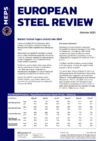Construction sector growth has limited effect on Spain’s steel prices
Spain’s position as one of Europe’s fastest-growing economies is not being fully reflected in its steel prices, despite robust growth in the country’s construction sector.
The country’s construction sector is expected to grow by 4.2% this year, according to EuroConstruct, with business confidence in the sector recently reported at its highest level since 2006. This expansion is a key contributor to Spain’s GDP growth, which is forecast to end 2025 at 2.9%, according to the latest data published by the IMF.
Spain’s positive construction sector performance comes in sharp contrast to that seen in most EU countries and is largely attributed to the country’s shortage of residential homes.
- Regular insight into the Spanish steel market is featured in MEPS’s European Steel Review. The monthly publication also includes market commentaries, prices, price indices and six-month price forecasts for Belgium, France, Germany, Italy and the United Kingdom.
Despite this, steel prices in Spain have remained subdued, following the bloc’s wider trend. A lack of demand in neighbouring countries have limited the scope for price increases.
MEPS’s rebar prices are currently 5.3% up on their 2024 average and 19.7% above the year-to-date average price recorded in Italy. As well as demand from residential building projects, the June closure of Grupo Industrial Cristian Lay's Corrugados Getafe steel plant, outside Madrid, may also have contributed some upward pressure to rebar prices.
However, steel beam prices are at their lowest level since June last year. They also represent the lowest among countries assessed for MEPS’s European Steel Review (Belgium, France, Germany, Italy, Spain, UK).
Valencia flood reconstruction
Twelve months after devastating floods experienced in Valencia, MEPS respondents report that steel demand from Spain’s construction sector could increase further due to investment in the region’s reconstruction.
For 2025, GDP growth for the Valencian region, Comunidad Valenciana, has been estimated at around 2.7-3.3% by the Independent Authority for Fiscal Responsibility, while the contribution of the construction sector has been growing.
Reconstruction works have been underway following the floods at the end of October last year, which killed 227 people and caused unprecedented destruction to homes, businesses, infrastructure, vehicles and agricultural land.
To date, service centres and distributors interviewed by MEPS in the region report fairly good sales volumes for construction steel, albeit not strong. This has failed to push up prices and profit margins continue to be very tight in the sector, they say.
Protracted recovery is ongoing
Moreover, some businesses in the region remain shut as a result of flood damage. Others have only partly recovered their activity levels. This has been negatively affecting demand for steel. There have been delays in the handing out of financial support and subsidies, some respondents to MEPS's research for its European Steel Review.
To date, the Valencia region’s volume of car sales has increased as a result of the October 2024 flooding. Over 100,000 vehicles were destroyed in the disaster. Some MEPS respondents suggest that this had a direct effect on an increase in the number of new car sales, which showed growth of 14.8% in first nine months of the year, to 854,658 units, according to the Spanish Automotive Association, Anfac. However, Spanish automotive production declined by 5.2% in the same period, reaching 1.70m units.
For 2026, the IMF estimates that Spain’s GDP growth will be 2%, up 0.2 percentage points on its spring forecast and well above the eurozone's forecast of 1.2%.
In August, the European Commission made a payment of more than EUR23bn to Spain as part of a Recovery, Transformation and Resilience Plan. This is the largest payment made by the Commission to a member state and is expected to create steel demand in various sectors. Among the areas set to benefit from the new funding are renewable energy projects and infrastructure developments, particularly in the rail sector.
Nonetheless, MEPS steel price forecasts indicate that steel prices will rise amid expectations of tightening supply, rather than any uptick in demand. MEPS expects long product values to follow a stable-to-slight-upward trend in late 2025 before rising until mid-2026 as CBAM taxes and new EU trade defence measures begin to restrict imports, prompting domestic mills to push for price increases.

Source:
European Steel Review
The MEPS European Steel Review is an informative, concise and easy-to-use monthly publication, offering unique professional insight into European carbon steel prices.
Go to productRequest a free publication





